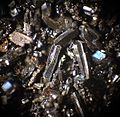Carbon group
Carbon group or carbon-silicon group denotes the 4th main group ("tetrels", rarely also "tetogens" (framework formers)) (according to new numbering of IUPAC group 14) of the periodic table. It includes the elements carbon (C), silicon (Si), germanium (Ge), tin (Sn), and lead (Pb). A radioactive element, flerovium (Fl), is also represented.
· 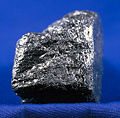
Graphite
· 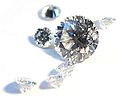
Diamonds
·
C60 fullerene
· ![]()
high-purity silicon
· 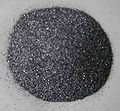
Silicon powder
· 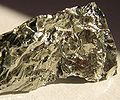
Germanium
· 
α and β tin
· 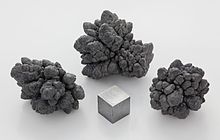
Lead
Properties
The elements of the carbon group have very different chemical and physical properties because the group is split in two by the dividing line between metals and nonmetals. The first element of the group, carbon, is a nonmetal, the next two (silicon and germanium) are semimetals, and all the others (tin, lead, and flerovium) are metals.
Physical properties
With increasing atomic number, atomic mass, atomic radius and ionic radius grow. The density of graphite (C) and silicon are close together (approx. 2.3 kg/dm3), it increases within the main group up to lead to 11.34 kg/dm3. There is also a wide range in Mohs hardness, from a maximum of 10 for diamond to a minimum of 1.5 for tin. Tin has the highest electrical conductivity with 9.17 MS/m, silicon the lowest with 25.2 mS/m. The 1st ionization energy decreases with increasing atomic number from 11.26 eV for carbon to 7.34 eV for tin. Lead has a slightly increased value again with 7.42 eV. The electronegativity tends to decrease with increasing atomic number from 2.5 (C) to 1.6 (Pb), the outlier with 1.7 is silicon.
| Item | Atomic mass | Melting point | Boiling point | Density | Mohs hardness | Electr. conductivity | Electronegativity |
| Carbon | 012,011 | 3823 | 5100 | 2250 to 3510 | 0.5 to 10.0 | 10−4...10+6,5 | 2,5 |
| Silicon | 028,086 | 1683 | 2628 | 2330 | 6,5 | 2,52 · 10−4 | 1,7 |
| Germanium | 072,590 | 1211 | 3093 | 5323 | 6,0 | 1,45 | 2,0 |
| Tin | 118,710 | 0505 | 2875 | 7310 | 1,5 | 9,17 · 106 | 1,96 |
| Lead | 207,200 | 0601 | 2022 | 11340 | 1,5 | 4,81 · 106 | 1,6 |
Electron configuration
The electron configuration is [X] ys2yp2. The X stands for the electron configuration of the noble gas one period higher, and for the y the period in which the element is located must be inserted. Starting with germanium, there is also a (y-1)d10 orbital; and starting with lead, there is also a (y-2)f14 orbital.
For the individual elements, the electron configurations are:
- Carbon: [ He ] 2s22p2
- Silicon: [ Ne ] 3s23p2
- Germanium: [ Ar ] 3d104s24p2
- Tin: [ Kr ] 4d105s25p2
- Lead: [ Xe ] 4f145d106s26p2
- Flerovium (calculated): [ Rn ] 5f146d107s27p2
The oxidation states are +4 and -4, but as the atomic number increases, the oxidation state +2 becomes more important.
Chemical reactions
Due to the large differences within the group, it is difficult to give a general reaction behaviour, as this varies from element to element. In the following equations, the E stands for an element from the carbon group.
- Reaction with oxygen:
The most important reaction is the formation of the respective dioxide from the elements.
In addition to the tetravalent oxides, the divalent oxides of all group elements are also known. The stability of the divalent oxides increases with increasing atomic number, that of the tetravalent oxides decreases somewhat. In addition, various sub- and mixed oxides are known, such as the carbon suboxide C3O2 or the lead(II,IV) oxide Pb3O4.
- Reaction with hydrogen (without chain formation, not spontaneous):
- Reaction with water:
None of the group elements react with water.
- Reaction with halogens (using chlorine as an example):
Carbon, silicon and germanium react only to the tetrachloride, with tin SnCl4 and SnCl2 are possible and lead forms only the dichloride PbCl2.
Chain formation
A special feature of the group 14 elements is their ability to form long-chain hydrogen compounds of the structure XH3-(XH2)n-XH3. All hydrogen atoms are covalently bonded, but the stability of these compounds decreases with increasing atomic number of the element.
- Hydrocarbons: The group of hydrocarbons is the most extensive, since there are hardly any limits to the number of C atoms and thus also to the chain length. Another specific property of carbon is the ability to form stable double and triple bonds. Organic chemistry deals with hydrocarbons and their derivatives.
- Silanes: In silicon, the ability to form chains is already limited to a maximum of 15 Si-Si bonds. Double or even triple bonds are unstable in silicon and the following elements, but even the silanes are not among the most stable compounds.
- Germane: Germanium is only capable of a maximum of nine Ge-Ge bonds. This, of course, greatly limits the possibilities.
- Tin hydrogens: In the case of tin, only a single Sn-Sn bond is possible. Therefore, there are also only two compounds of this class: SnH4 and SnH3-SnH3.
- Hydrogen lead: Lead does not have the ability to form chains. Only PbH4 is known, but even this compound is almost unstable.
Ring formations are also possible, the molecular formula is then (XH2)n.
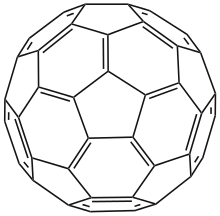
C60 fullerene
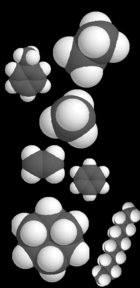
Calotte models of some hydrocarbons
Connections
- Oxides (IV), hydroxides and acids
- Due to the stability of the C=O double bond, carbon dioxide (CO2) is a triatomic, linear and therefore non-polar molecule and exists in the gaseous state of aggregation. In water it forms the unstable, weak carbonic acid (H2CO3).
- Only single bonds exist in silicon dioxide (SiO2). It is a solid and consists of SiO4 tetrahedra, which are linked together at all corners. In nature SiO2 occurs as quartz. Amorphous SiO2 (silica glass) is the essential component of glass.
- Germanium dioxide (GeO2) essentially corresponds to silicon dioxide, but can also crystallize in the rutile structure. The latter forms germanic acid (H4GeO4) with water.
- Tin(IV) oxide (SnO2) is a solid and not soluble in water.
- Lead(IV) oxide (PbO2) is also a solid insoluble in water.
- Hydrogen compounds: see under chain formation
- other:
- Carbon monoxide (CO) is a poisonous gas.
- Silicon monoxide (SiO) is a dark brown, amorphous solid composed of polymeric (SiO)x chains.
- Silicones consist of three-dimensional networks of alternating silicon and oxygen, whereby organic residues (for example methyl groups (-CH3)) are usually found on the silicon atoms.
- lead (II) oxide
- Lead (II,IV) oxide

Carbon dioxide

Silicon dioxide
Search within the encyclopedia
